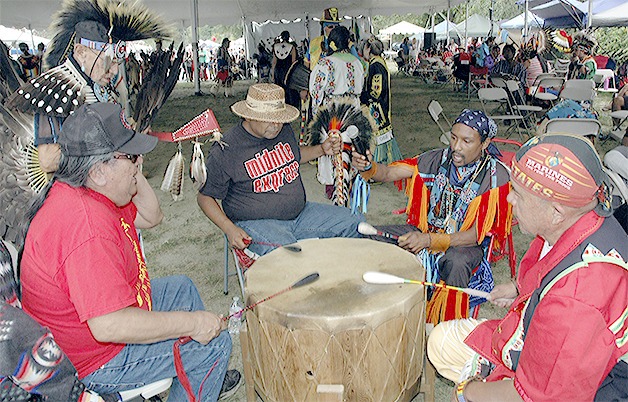ARLINGTON — After 26 years, the Stillaguamish Festival of the River and Pow Wow packed the grounds of River Meadows County Park as full as ever Aug. 8-9.
However, the Stillaguamish Tribe admitted to concerns about how continued low levels on the river could affect future salmon harvests.
There was no shortage of freshly cooked salmon for festival attendees. Jason Griffith, a fisheries biologist with the tribe, answered festival-goers’ questions, and noted that any possible impact on the salmon, due to current river levels, wouldn’t be felt for a while.
ADVERTISEMENT
0 seconds of 0 secondsVolume 0%
Press shift question mark to access a list of keyboard shortcuts
Keyboard Shortcuts
Shortcuts Open/Close/ or ?
Play/PauseSPACE
Increase Volume↑
Decrease Volume↓
Seek Forward→
Seek Backward←
Captions On/Offc
Fullscreen/Exit Fullscreenf
Mute/Unmutem
Decrease Caption Size-
Increase Caption Size+ or =
Seek %0-9
“We are concerned, but we simply don’t have enough information yet, to know how much this will affect fish right now,” Griffith said. He added that such impacts could take as long as six years to make themselves evident. “We’ll be measuring the smolt levels in the spring, and checking spawning levels, but we’re still in a holding pattern.”
Griffith speculated that predicted cooler and wetter conditions later in August could compensate for the year’s warmer, drier weather to date.
“This is all too soon for it to have had much of an impact on the adult and juvenile salmon, but it could affect the coho, chinook and steelhead coming up,” Griffith said. “We’re concerned because low flows and high temperatures will obviously put stresses on the fish, but we don’t have the hard data yet to measure any mortality rates.”
In the meantime, the tribe will continue to do what it’s done for 25 years, by supplementing levels of coho, chinook and chum through their hatcheries.
“We make sure they don’t imprint on hatchery waters, so they have a higher rate of survival, to bolster runs of those species in the wild,” Griffith said.
Griffith cited the tribe’s success in stabilizing coho levels, which had previously been unsteady.
“They’re not fully recovered, but they’re a lot better than where they were before,” Griffith said.
For many attendees, the festival was less about ecological concerns and more about recreation and self-expression. Kevin Ricco of Mount Vernon was one of the lumberjacks to take part in the pole-climbing contest, while Vancouver’s Delayne Corbett and Poulsbo’s Charlie Beaulieu collaborated on a towering sand sculpture. Jimmy Kitchens came all the way from Alaska to demonstrate his chainsaw-carving skills, and the annual pow wow drew dancers from as far away as New York, such as Dianne Palmer-Manheimer, who takes pride in her combination Mohawk-German heritage.
“It’s a very social thing,” said Bob Red Elk, a Sioux Indian who’s lived in and around Seattle and Bellingham for 20 years, and attended pow wows for just as long. “You get to see people you haven’t seen in a while. It’s not about fulfilling anyone else’s expectations. We’re just in harmony with each other and can enjoy ourselves.”
Fellow Washington native McHale Mansfield is much younger, but the 21-year-old Yakama Indian has been going to pow wows as far away as Utah since he was 5.
Much of Mansfield’s pow wow regalia comes from his father, who passed away when he was very young, so the younger Mansfield sees it as a way of carrying on traditions.
“I love the friendships and family that are part of pow wows,” Mansfield said. “It gets you more socially involved. When you do pow wows, you have more success in school, and you join more clubs. Those things build on each other. It’s a great way to get rid of fear, because you can’t have performance anxiety when you dance.”







